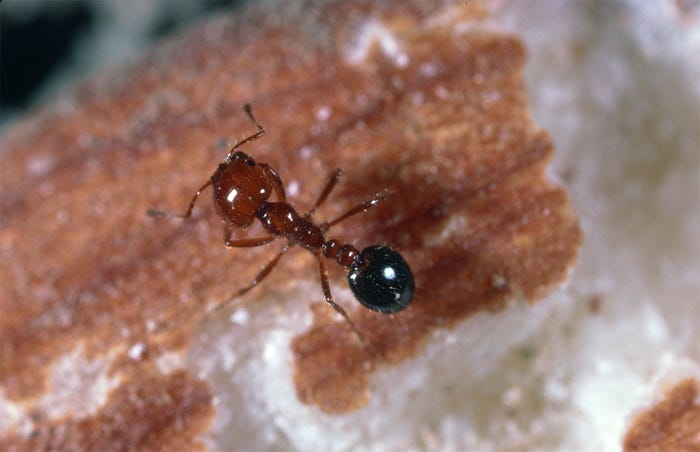
With warmer weather upon us ants are marching in almond orchards seeking food – nuts.
Kris Tollerup, University of California (UC) integrated pest management advisor, reports that ant mounds showed up earlier than usual this spring.
Determining whether an ant species can cause direct damage to almonds is a good first step toward ant control. Only several of the 270 ant species found in California cause direct damage to almonds. That’s the good news.
From Fresno to Kern counties, the bad news is the California fire ant and southern fire ant are the most damaging species. The southern fire ant and pavement ant are found in Central California growing areas.
In the Sacramento Valley, the pavement ant is the key damaging specie. A less common specie is the thief ant. Both economically harmful ants and non-pest ants are likely in almond orchards where the crux is early identification.
The pavement ant is dark brown in color and covered with coarse hairs. These ants travel in a single file line in search of food. They prefer to nest in sandy or loamy soils where the soil temperature is from 58 to 82 degrees Fahrenheit.
The southern fire ant has an amber-colored head and thorax and a black abdomen. Fire ants swarm out of their nest entrance when disturbed and can inflict a painful sting. They should not be confused with the red imported fire ant which is much more aggressive.
Southern fire ant nests are usually found on the edges of wet areas in the orchard. In flood-irrigated orchards, the nests are usually found on berms. Nests can also be found next to weeds including nutsedge and spotted spurge. Both species are more active in the morning and late afternoon.
These ant species damage windrowed almond kernels. First signs of ant infestations are a scraped- or peeled-appearance on almond skins. With heavy ant infestations, kernel feeding occurs, minus webbing or frass.
To determine if pest ant species are present, Tollerup suggests using 20 small containers with a little baloney meat inside each one. Place the containers about four trees apart early in the morning.

The southern fire ant (pictured) is one of the most damaging ant species in almond orchards.
At mid-day, cap the containers and place in a freezer overnight. Species of the frozen ants can be identified the next day using UC Statewide IPM Program website guidelines.
Note that ants seen traveling up and down tree trunks are not pest species, Tollerup says. Some ants protect honeydew-producing insect pests, but in almond orchards they are more likely feeding on extra floral nectaries and not tending to pests.
These include the native gray ant, pyramid ant, and California harvester ant. The first two ants feed primarily on other small insects and arthropods while the harvester ant feeds exclusively on small seeds.
Ant colony surveys in orchards should be completed from April through May in the southern San Joaquin Valley and by June in northern almond growing regions.
The numbers of pest ants and the length of time which almonds dry on the ground determine the amount of nut damage. Information on thresholds can be found in the UC Almond Pest Management Guidelines.
The general guideline is that finding three or more ant mounds per 1,000 square feet of orchard increases the chances for nut damage at harvest. Damage from the southern fire ant is temperature driven. High daytime temperatures while nuts are drying can slow southern fire ant feeding.
Baits are the best control method for ants and the timing is important. UC guidelines include effective baits including insect growth regulators (IGR) and stomach poison baits. IGR baits include Esteem (pyriproxyfen) and Extinguish (methoprene). The stomach poison baits are Clinch (abamectin) and Altrevin (metaflumizone).
According to Certis USA, other attract and kill baits include Seduce and Bug-N-Sluggo (spinosad). The company says the grower can see immediate knockdown with attract and kill baits.
IGR baits may work slower than poison, taking up to eight weeks before significant control. Stomach poison bait effectiveness can be seen in about three weeks.
About the Author(s)
You May Also Like




